Hobbyists or serious reefers, everyone wants to have the coolest fish collection in their saltwater aquarium. A reef system with a school of eye-catching fish is like a dream for them. So, it needs some looking into to find the coolest ones that are also the most suitable for a captivated environment.
Some of the stunners you can keep in your reef tank include Seahorse, Batfish, Jellyfish, Boxfish, Lionfish, Triggerfish, Pufferfish, and Hawkfish.
What do they have that makes them distinguishable from others? Why are they a must-have for a reef owner? I will familiarize each with you so that you get the answers for yourself.
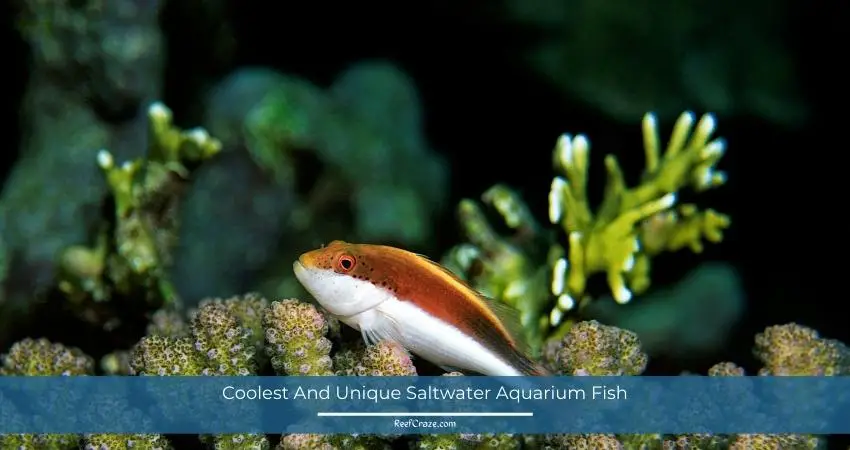
8 Coolest And Unique Saltwater Aquarium Fish
I have enlisted 8 fish that you must consider for your saltwater aquarium. Now, note that the list has no order, and I chose the fish based on their appearance, uniqueness, characteristics, sizes, colors, and popularity. And, of course, the list could have gone on and on, but I limited it to the most strange-looking and available ones.
Another point is that each fish, Seahorse, Jellyfish, Lionfish, Triggerfish, Boxfish, Hawkfish, Batfish, and Putterfish, has multiple subcategories, among whom I chose the most sought-after one.
So, to be more specific with the subcategorization, they are Crosshatch Triggerfish, Dwarf Seahorse, Yellow Boxfish, Volitan Lionfish, Longnose Hawkfish, Moon Jellyfish, and Pinnatus Batfish. Detailed overviews of the fish will help you build your dream aquarium system following this section. Have a read.
1. Dwarf Seahorse (Hippocampus Zosterae)
Going by Seapony, the Dwarf Seahorse is an extremely demanding fish because of their difficult feeding habits. You must constantly feed them freshly-hatched copepods, baby brine shrimps, and shrimp larvae. Such pickiness of their characters often makes it challenging to have them in home tanks.
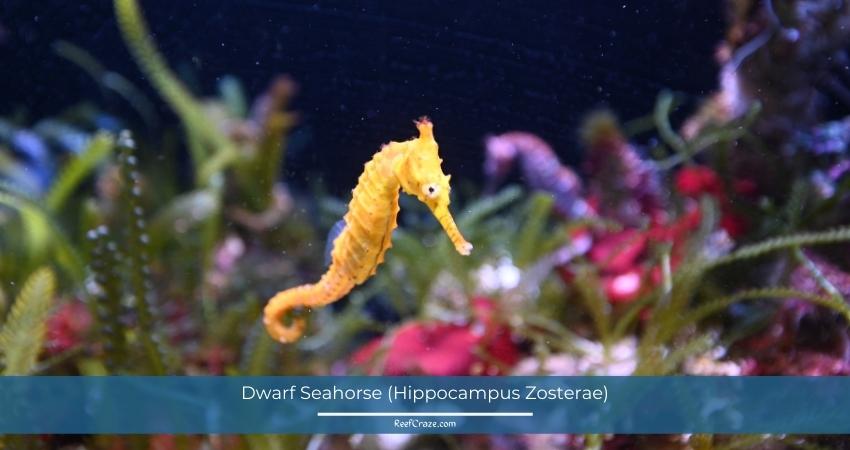
Anyway, do not mistake thinking that people avoid them for their high maintenance. In fact, Dwarf Seahorses are famous for their adorable size and yellow color, making them highly desirable among reef owners.
You should keep Seahorses in a Seaahorse-only tank in mini schools of 4 to 6 members. They are not friendly with others, excluding Pipefish and small passive fish. Finding the wrong neighbors will create a hostile environment inside your aquarium. So beware of who you are putting with the littluns.
You can keep 4 to 6 Seahorses in a little 10-20-gallon reef tank. A larger one will house more if that is what you want.
Profile Overview:
| Scientific Name | Hippocampus zosterae |
| Family | Syngnathidae |
| Life expectancy | 1 year |
| Suitable for | Experienced reef owners only |
| Size | 2 inches |
| Suitable tank mates | Starfish, Pipefish, and small Hermits |
| Temperament | Peaceful |
| Diet | Carnivore |
| Minimum tank size | 10-20 gallons |
| Origin | Caribbean |
| Colors | Yellow, tan, white, and black |
| Water parameters | pH 8.1 to 8.4, dKH 8 to 12, 72 to 78 degrees F, sg 1.020 to 1.025 |
| Price | $45 to $70 |
2. Crosshatch Triggerfish (Xanthichthys Mento)
You may also know the Crosshatch Triggerfish as Blue Cheekline Triggerfish. It has a unique color pattern combining a blue body with orange-edged fins and a yellow-edged tail. You are bound to notice it first in an aquarium brimming with fish.
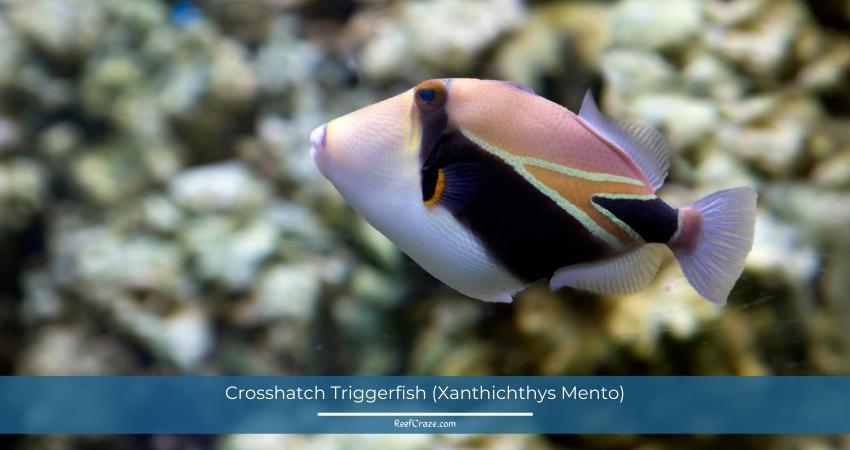
To give you a more detailed description, the Triggerfish has a face of blue lines all over its body from its mouth to its gills. The fins also have a fascinating blue color, bordered with red. Then there is the yellow tail.
An interesting fact about Triggerfish is its noise-making characteristic. It creates a grunting sound. However, it is not clear whether the sound is for communicating with others or sending them a signal about potential predators.
The fish will grow to around 12 inches in a home tank. So you must have a 180-200 gallon tank to guarantee their maximum development in a confined environment.
Since they are quite rare to find for sale, each Blue Cheekline will cost you a fortune of $1200. But their upkeep is pretty easy for anyone.
Profile Overview:
| Scientific name | Xanthichthys mento |
| Family | Balistidae |
| Size | 11-12 inches |
| Life expectancy | 10 to 15 years |
| Suitable tank mates | Wrasses, tangs, and butterflyfish |
| Maintenance | Beginner-friendly |
| Diet | Carnivore |
| Temperament | Semi-aggressive |
| Colors | Yellow, red, blue, greenish |
| Price | $800 to $1200 |
3. Yellow Boxfish (Ostracion Cubicus)
Cubicus has several names: Polka Dot Boxfish, Cube Boxfish, Blue-Spotted Boxfish, White Cubicus, and Yellow Boxfish. People often mistake it for the Longhorn Cowfish. And that is fair enough because they both have a similar physical structure.
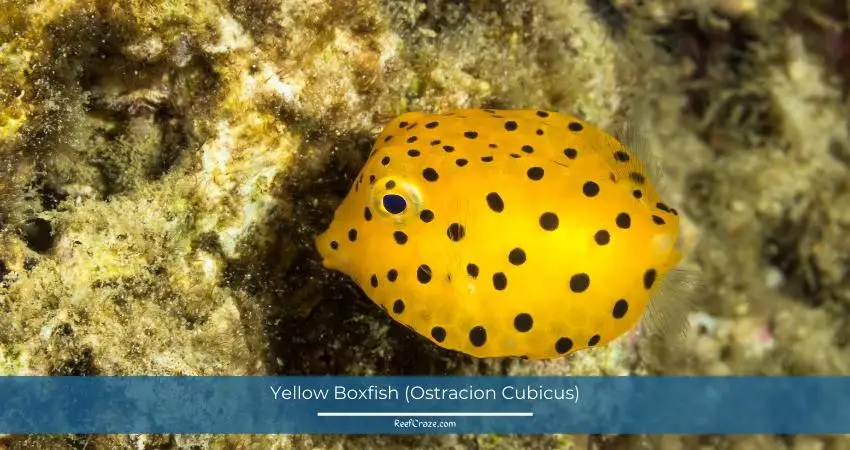
Apart from its compelling look, the Polka Dot fish is famous as an expert-level saltwater fish. In its younger days, it has tiny and bright yellow spots. But they become brownish as it gets older.
Despite its small size and shape, it lives on invertebrates like tubeworms and can grow up to 15 to 18 inches. So, maintain caution if you plan to add it to your tank. You can also feed it flaked, frozen, and dried fish.
Another reason for concern is the poisonous element ostracitoxin that its mucous glands release when under stress. It will immediately kill the other living beings in the aquarium. Expect no reef safety from this fish even though it generally has a calm nature.
Apparently, it is not as innocent as it looks and can be dangerous for other fish. Be thoughtful while selecting its tankmates. It even has a notorious record of obliterating an entire tank of fish!
Profile Overview:
| Scientific name | Ostracion cubicus |
| Family | Ostraciidae |
| Size | 15 to 18 inches |
| Origin | Read Sea and Indo-Pacific |
| Suitable for | Experienced reef owners only |
| Diet | Omnivore |
| Life expectancy | 8 years+ |
| Temperament | Semi-aggressive |
| Capable of endangering others | Only when stressed |
| Suitable tank mates | None (because of their toxic substance) |
| Water parameters | pH 8.1 to 8.4, dKH 8 to 12, 72 to 78 degrees F, sg 1.020 to 1.025 |
| Price | $40 to $50 |
4. Volitan Lionfish (Pterois Volitans)
Does the cool- and calm-looking Lionfish give you a feeling that it is dangerous? Then you are right. It absolutely is.
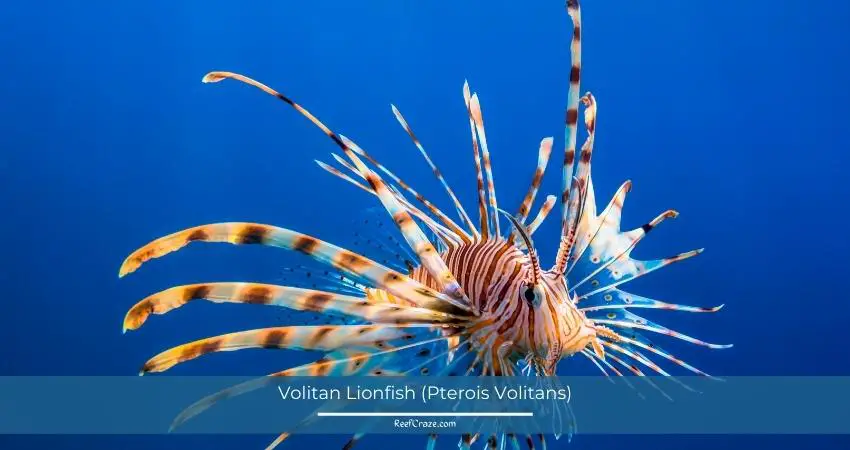
A large part of its body is venomous, i.e., the spines on its pelvic, anal, and dorsal fins, which come in handy during self-defense. If it stings you, you will feel like getting stung by wasps or bees, but worse.
Lionfish venom has proteins that heat can break and prevent from accessing the bloodstream. So, while it does not threaten your life, it will hurt you immensely. You may also experience allergic reactions. Therefore, get yourself medical treatment at the earliest.
A lionfish can grow as much as 15 inches and should live with similar-sized fish. Anything small will be at risk of becoming its food. And when it develops fully, you should place it in a larger tank with plenty of hiding places. They are necessary for it to hide when acclimating to the new environment.
You can feed it shrimp and dried foods, but its main diet is live foods. Sometimes people buy inexpensive freshwater fish and goldfish for them, but that can spread disease inside your aquarium. So, make sure you give your fish harmless food.
Volitan Lionfish are undeniably a piece of work in terms of maintenance and characteristics. But they will also be the most attention-grabbing fish in any saltwater tank.
Profile Overview:
| Scientific name | Pterois volitans |
| Family | Scorpaenidae |
| Origin | Indo-Pacific and East Pacific |
| Minimum tank size | 100 to 130 gallons |
| Life expectancy | 10 years |
| Temperament | Semi-aggressive |
| Diet | Carnivore |
| Suitable tank mates | Snowflake Moray Eel, Anglerfish, Blue Tang, Foxface Rabbitfish, Clown Triggerfish, Panther Grouper, Maroon Clownfish, Threadfin Butterflyfish, Harlequin Tusk Fish, and Rock Beauty Angelfish |
| Size | 15 inches |
| Origin | Indonesia, the Caribbean, and Vanuatu |
| Water parameters | pH 8.1 to 8.4, dKH 8 to 12, 72 to 78 degrees F, sg 1.020 to 1.025 |
| Price | $55+ |
5. Longnose Hawkfish (Oxycirrhites Typus)
You can identify a Longnose by its lengthy snout. Its white physique with a gorgeous orange pattern will be instantly visible in any tank. It generally swims alone or with 3 or 4 others in a natural space.
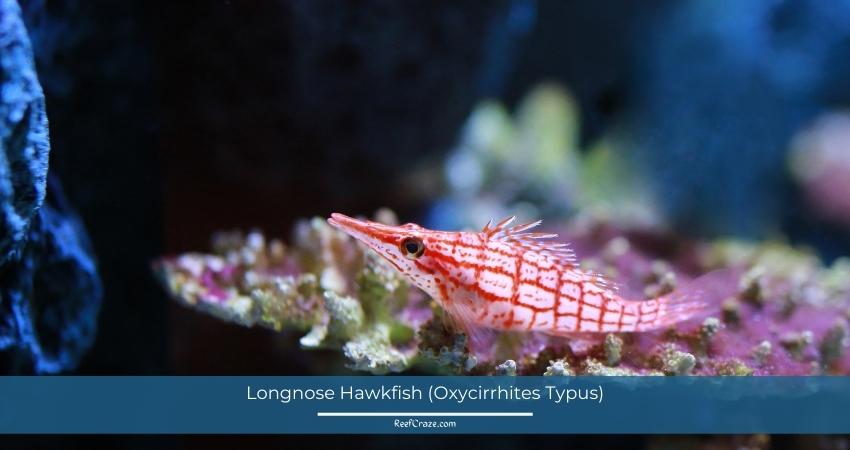
It is a worthy addition to a reef tank because of its lively colors and distinct perching method. It is a high-spirited fish with an intelligent personality, granted that it has sufficient space to grow. Other than its appearance, hobbyists love it for its low vulnerability to diseases.
When you bring it in a home tank setting, you should keep only one unless your reef system is spacious enough to shelter more. Besides, it has to have rock features to give the fish plenty of places to relax or hide whenever necessary. The lid should be tight so they do not fall out of the water when jumping.
It is peaceful and playful in nature. Making a fine pet, it will not be retiring at all. When you approach the tank to give it food, it will learn to resurface faster and receive its treats.
The diet habit of the Longnose involves smaller snails, crabs, and invertebrates. And although they are not usually threatening to corals, they can nip at them when underfed. An effective way to prevent that is to keep them well-fed. It is also aggressive toward small fish and invertebrates.
Profile Overview:
| Scientific name | Oxycirrhites typus |
| Family | Cirrhitidae |
| Origin | Indian and Pacific oceans |
| Temperament | Semi-aggressive |
| Maintenance | Simple to medium |
| Size | 4-5 inches |
| Suitable tank mates | Dwarf Angels, mid-sized Wrasses, most Damselfishes, and larger Blennies and Gobies |
| Diet | Carnivore |
| Life expectancy | 10 years |
| Minimum tank size | 30 gallons |
| Water parameters | pH 8.1 to 8.4, 76 to 80 degrees F |
| Price | $80 to $90 |
6. Dogface Pufferfish (Arothron Nigropunctatus)
This one has to be the oddest yet most adorable fish on my list. It is also my favorite one. I mean, think of a fish that looks less like a fish and more like a dog! How strange (AND COOL) is that?
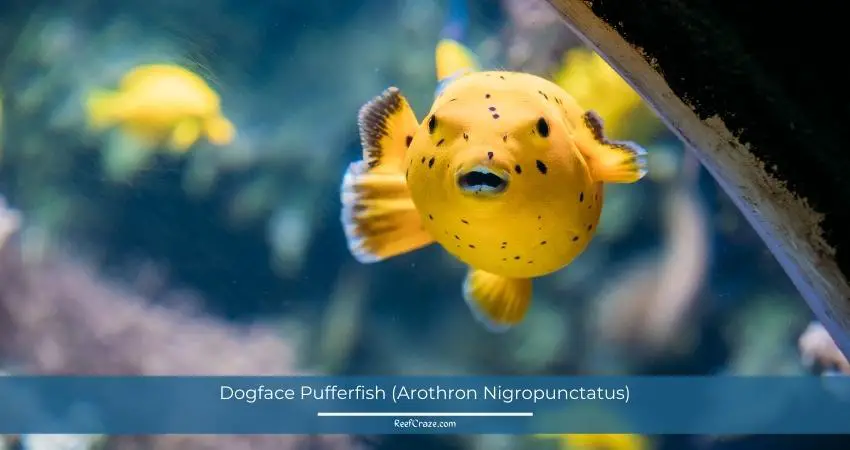
The name says all about its appearance and personality: Dogface Pufferfish. They come in 2 colors: a bright grey and a light golden yellow, resulting possibly from sexual differences, growth or maturity, and regional variants. You may also know it by the Blackspotted Pufferfish.
Although some people do not find the look resemblance, they have to agree that Dogface has a very dog-like personality. Every Puffer is personable, but Dogface is on a whole new level. It will immediately distinguish its owner from others. You can even train it to get used to hand-feeding and stroking underwater.
It becomes quite sizable over time but remains gentle and peaceful towards all tank mates except invertebrates. A 125-gallon is more comfortable for them, but a 75-gallon will do too.
A Guineafowl will make a nice option if you consider having other Puffers. They can coexist in harmony. But I would not recommend keeping more than one Dogface in a tank.
Profile Overview:
| Scientific name | Arothron nigropunctatus |
| Family | Tetradontidae |
| Origin | Indian ocean |
| Size | 12 inches |
| Temperament | Calm |
| Minimum tank size | 75 gallons |
| Suitable tank mates | Angelfish, Snowflake Eel, and Triggerfish |
| Maintenance | Medium to high |
| Life expectancy | 10 years |
| Diet | Carnivore |
| Water parameters | pH 8.1 to 8.4, dKH 8 to 12, 72 to 78 degrees F, sg 1.020 to 1.025 |
| Price | $100 to $300 |
7. Moon Jellyfish (Aurelia Aurita)
Most fish I have discussed so far have rigid requirements that demand expertise. So that may discourage beginners from having them as their first pets. Here goes a really easygoing saltwater fish for them, a most common one, but with a soothing appearance and mild upkeep.
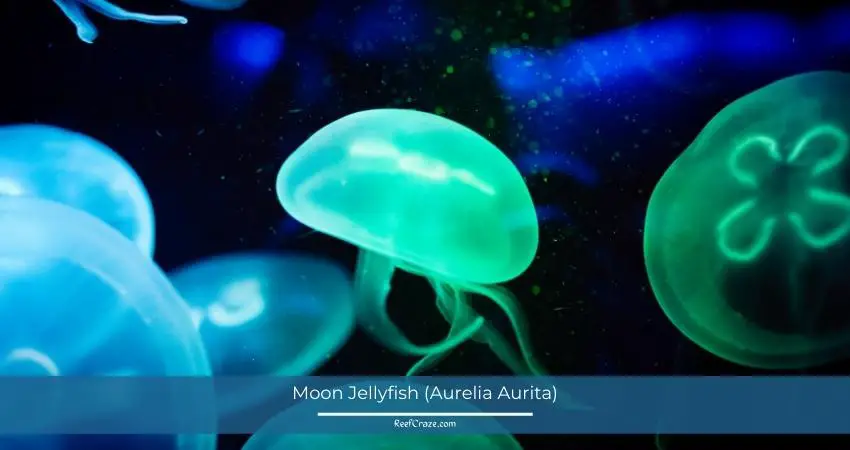
Moon Jellyfish, a particular group of Jellyfish, is also known as Saucer Jelly. Smaller than some Jellyfish, it is only 3 inches long with a nearly nonexistent weight between 0.005 and 0.07 pounds. While most grow as wide as 7 to 8 inches, some are double that width.
There are various colors of Moon Jellies. Some are white during their birth. Afterward, their moon-shaped structure becomes shades of purple, pink, and blue as they grow. It supposedly depends on their eating habit.
Translucent, they often appear glowing due to the reflection of the sun in the tank water, making them look ethereal. That, with their relaxing movements, will soothe your mind after a long day.
As harmless as it looks, you cannot put it with others. In fact, you cannot get it to live with other species of Jellyfish. It will either be alone or with other Moon Jellyfish.
Like other Jellies, Moon Jellyfish mainly live on small animals like krill, pelagic copepods, phytoplankton, and brine shrimp. You can prepare a combination with some of them or simply give them neatly sized seafood.
Profile Overview:
| Scientific name | Aurelia Aurita |
| Family | Ulmaridae |
| Origin | Indian, Pacific, and Atlantic oceans |
| Life expectancy | 10 to 12 months |
| Size | 3 inches |
| Diet | Carnivore |
| Maintenance | Low |
| Tank Setup | Circular or rectangular |
| Suitable tank mates | None (only Moon Jellyfish) |
| Suitable for | Beginners |
| Minimum tank size | 5 gallons |
| Temperament | Semi-aggressive |
| Water parameters | pH 8.0 to 8.2, 42 to 66 degrees F, sg 1.025 |
| Price | $30 to $55 |
8. Pinnatus Batfish (Platax Pinnatus)
The Pinnatus Batfish, with its dark black body bordered with a flashy orange, will be the star of any reef tank. You can call it Pinnate Spadefish, Dusky Batfish, Pinnate Batfish, Red-Faced Batfish, or Shaded Batfish.
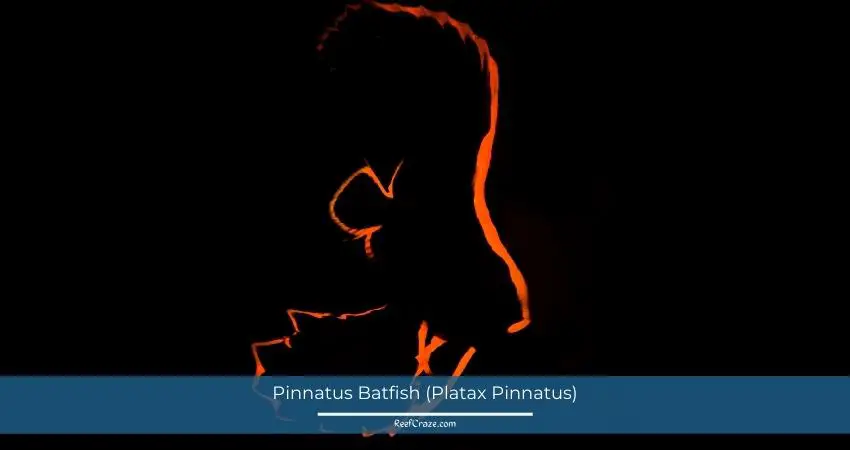
Its dark black body covered with orange makes it a unique and desired choice among fish keepers. However, it is not for everyone for its maintenance difficulty in captivity. You may fail to keep it alive for several weeks without sufficient experience.
Pinnatus’ temperament is stubborn, and it typically eats anything it can collect on its own, both plants and animals.
It is highly engaging, clever, and personable. You can even hand-feed it. It looks delicate when younger, but it can grow to be hardy and long living with proper care.
Speaking of growth, the Batfish can get as large as 30 inches. So you will need an above-average fish tank with a 200-300 gallons capacity. It may seem too much, but it is essential for the fish’s survival. If it cannot feel comfortable, it will suffer from stress and die soon.
Profile Overview:
| Scientific name | Platax pinnatus |
| Family | Ephippidae |
| Origin | Pacific ocean |
| Life expectancy | 5 to 12 years |
| Size | 16 to 30 inches |
| Diet | Omnivore |
| Maintenance | High |
| Suitable for | Experts |
| Minimum tank size | 300 gallons |
| Tank Setup | FOWLR, Saltwater |
| Temperament | Gentle |
| Water parameters | pH 8.2 to 8.4, 77 to 80 degrees F, sg 1.018 to 1.025 |
| Suitable tank mates | Gobies, Tangs, and Clownfish |
| Price | $80 to $100 |
Final Words
There are more fish than the ones I put on my list of the coolest and unique saltwater aquarium fish. You can look up others and do more research.
Most of them are not beginner-friendly. Some of them need specific tank setups. But you can practice with the manageable ones and proceed with the others after gaining some experience.
Nonetheless, each fish requires specific maintenance criteria that you must fulfill to keep them healthy. Try to maintain them all as appropriately as possible to enjoy the entrancing beauty of your beloved pets.
